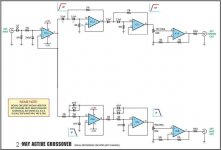Hello Dears,
I am try to go active on the bass with a II order active crossover with a Linkwitz-Riley slope (Q=0.5) as the one described here:
Active Filters
the II order xover should fit in my design pretty well based on calculations and measurements. While I want the highpass at fixed output, I would like to have the low pass adjustable.
The real problem to is how to buffer it.
Input buffer: my tube preamp needs at least 100KOhms load to really sing, and this spec is fully accomplished by my amp at the moment. Somebody suggested to used a a simple cathode follower tube buffer and to place the xover near the preamp.
Output buffer: the ideal situation would be to have an output which makes possible to adjustments in the range of +/- 3dB, so an output buffer and a volume pot is needed. Could you suggest some circuit that can do this.
Best Wishes
Pietro
I am try to go active on the bass with a II order active crossover with a Linkwitz-Riley slope (Q=0.5) as the one described here:
Active Filters
the II order xover should fit in my design pretty well based on calculations and measurements. While I want the highpass at fixed output, I would like to have the low pass adjustable.
The real problem to is how to buffer it.
Input buffer: my tube preamp needs at least 100KOhms load to really sing, and this spec is fully accomplished by my amp at the moment. Somebody suggested to used a a simple cathode follower tube buffer and to place the xover near the preamp.
Output buffer: the ideal situation would be to have an output which makes possible to adjustments in the range of +/- 3dB, so an output buffer and a volume pot is needed. Could you suggest some circuit that can do this.
Best Wishes
Pietro
Pietro,
Look on the same page you linked to. The buffer on the top of the page can be adjusted to 100K input impedance by changing the resistor.
For the output, scroll down a bit to item 10. There are several schemes for adjustable gain and output buffering.
Look on the same page you linked to. The buffer on the top of the page can be adjusted to 100K input impedance by changing the resistor.
For the output, scroll down a bit to item 10. There are several schemes for adjustable gain and output buffering.
> Could you suggest some circuit that can do this.
A current sourced JFET source follower using a pair of matched 2SK372Vs.
See also :
http://www.diyaudio.com/forums/pass...urce-follower-configurations.html#post1592491
Patrick
A current sourced JFET source follower using a pair of matched 2SK372Vs.
See also :
http://www.diyaudio.com/forums/pass...urce-follower-configurations.html#post1592491
Patrick
> compare datasheets for 2SK372 and 2SK363
http://www.diyaudio.com/forums/pass-labs/175040-more-fet-noise-measurements-evul.html#post2326966
There is of course another reason to use 2SK372 -- a thermal coupling one.
Patrick
http://www.diyaudio.com/forums/pass-labs/175040-more-fet-noise-measurements-evul.html#post2326966
There is of course another reason to use 2SK372 -- a thermal coupling one.
Patrick
Hi,
I still like the BF246A (and Philips BF247) which are easy to source, low-cap, lownoise and beefy (30-80mA). 😀
jauu
Calvin
I still like the BF246A (and Philips BF247) which are easy to source, low-cap, lownoise and beefy (30-80mA). 😀
jauu
Calvin
BF862 is a much better device, if you want to use BF246 and the like.
Much higher transconductance.
But then 2SK372 is even better.
Just search the jfet posts by Scott Wurcer in the Solid State forum.
Patrick
Much higher transconductance.
But then 2SK372 is even better.
Just search the jfet posts by Scott Wurcer in the Solid State forum.
Patrick
Last edited:
- Status
- Not open for further replies.
- Home
- Source & Line
- Analog Line Level
- How to buffer a sallen-key circuit
